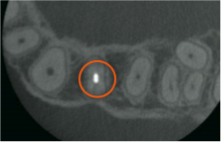Accurate positioning when acquiring a CBCT scan is critical to ensure the desired anatomy is captured and able to be reviewed. If a patient has restorations present in the mouth already, fine adjustments in positioning can make the difference between an easily readable or entirely non-diagnostic resulting volume. Larger FOV (field of view) scans are generally easier to position since most all CBCT units offer laser markers that give the technician a general sense of the anatomy that will be captured.
However, many offices find themselves wanting to capture a small FOV scan on a patient whose treatment plan focuses on a small area of the mouth, such as a single tooth or sextant. Small FOV scans are generally preferred for these situations as the dose to the patient is minimized, and the clinician mitigates risk by not imaging areas of anatomy beyond the region of interest (ROI). These sorts of scans are best acquired with software aided positioning functions, usually referred to as 'scouting'.
Many CBCT units offer 'panoramic scout' functions where the operator captures a panoramic x-ray of the patient, then moves to the acquisition PC to define the desired ROI and submit the setting to the CT unit, and then finally returns to the exposure switch to capture the 'scouted' CBCT scan. Through this process, the patient must remain in position for the scan; a process that can easily take a couple of minutes as the panoramic image is captured and reconstructed, the operator sets the scout position, and then the 3D scan is acquired.
J. Morita's X800 CBCT system introduced a new scouting method, the bi-directional scout, that saves time and reduces overall exposure to the patient while actually improving the accuracy of the scout. The region of interest is specified by taking lateral and frontal scout images in a single shot that completes in less than half the time of a traditional panoramic. These images are used to accurately position for a limited field CBCT exposure.
The unit's touch console offers a pictograph of a dental arch that can be used to specify the general ROI before the patient enters the unit. The patient is then positioned, and the bi-directional scout is captured. This scout image returns in less than half the time it takes for a panoramic x-ray to return, allowing the operator to more quickly set the exact ROI and send it to the machine.
Dental TI clients with the J. Morita X800 have enjoyed the bi-directional scout function to greatly reduce scan time and exposure dosage for their patients. Give us a call today at 1.800.672.5733 to learn more about J. Morita CBCT and how we can help you reduce downtime, boost profitability, and optimize diagnostic image quality.
However, many offices find themselves wanting to capture a small FOV scan on a patient whose treatment plan focuses on a small area of the mouth, such as a single tooth or sextant. Small FOV scans are generally preferred for these situations as the dose to the patient is minimized, and the clinician mitigates risk by not imaging areas of anatomy beyond the region of interest (ROI). These sorts of scans are best acquired with software aided positioning functions, usually referred to as 'scouting'.
Many CBCT units offer 'panoramic scout' functions where the operator captures a panoramic x-ray of the patient, then moves to the acquisition PC to define the desired ROI and submit the setting to the CT unit, and then finally returns to the exposure switch to capture the 'scouted' CBCT scan. Through this process, the patient must remain in position for the scan; a process that can easily take a couple of minutes as the panoramic image is captured and reconstructed, the operator sets the scout position, and then the 3D scan is acquired.
J. Morita's X800 CBCT system introduced a new scouting method, the bi-directional scout, that saves time and reduces overall exposure to the patient while actually improving the accuracy of the scout. The region of interest is specified by taking lateral and frontal scout images in a single shot that completes in less than half the time of a traditional panoramic. These images are used to accurately position for a limited field CBCT exposure.
The unit's touch console offers a pictograph of a dental arch that can be used to specify the general ROI before the patient enters the unit. The patient is then positioned, and the bi-directional scout is captured. This scout image returns in less than half the time it takes for a panoramic x-ray to return, allowing the operator to more quickly set the exact ROI and send it to the machine.
Dental TI clients with the J. Morita X800 have enjoyed the bi-directional scout function to greatly reduce scan time and exposure dosage for their patients. Give us a call today at 1.800.672.5733 to learn more about J. Morita CBCT and how we can help you reduce downtime, boost profitability, and optimize diagnostic image quality.




Leave Comment